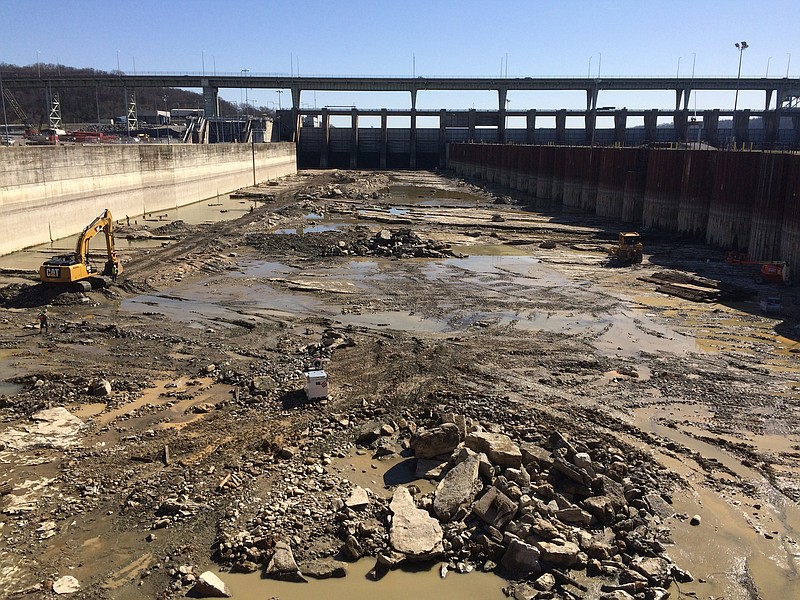The long-delayed construction of a new lock at the Chickamauga Dam is about to get noisier as blasting starts to help dig up the riverbed where the new and bigger lock is taking shape.
Kesco Inc., a blasting contractor from Zelienopie, Pa., will soon begin blasting the riverbed in the coffer dam erected below the dam to house the new 110-foot-by-600-foot lock.
Adam Walker, the project manager for the Chickamauga lock replacement project, said the lock excavation contractor, Heeter Geotechnical Construction, will establish the dates for the blasting according to their construction work schedule. Although the Army Corps of Engineers has not yet set the date to start the blasting, officials said it should begin within the next few weeks.
"Blasting dates are subject to completion of other construction activities leading up to the start of blasting such as completion of rock anchor installation along the existing cofferdam walls for a minimum of 250 linear feet from the blast location, and government approval of relevant blasting submittals," Walker said.
The rock blasting is more efficient and effective than mechanical removal of the riverbed bottom, Walker said.
But it will require advance notification of residents, boaters and motorists who cross the Thrasher Bridge on Highway 153 when the blasting occurs.
The company is limited to one blast per day totaling up to 100 throughout the project.
Blasting is allowed on Monday through Saturday during daylight hours except for heavy traffic hours on Highway 153 between 6:30 a.m. to 8:30 a.m. and afternoons between 3 p.m. and 5:30 p.m. No blasting is allowed on Sundays.
An air horn will be sounded three long times at five minutes before each blast, Kesco said in its announcement about the blasting work.
"The purpose of the excavation activity is to provide a sound rock foundation for construction of the new concrete lock walls," Walker said. "The rock excavation will remove approximately five feet of rock across the entire footprint of the new lock chamber, but localized excavations will go as deep as 32 feet in some areas."
The blasting and rock removal is expected to last for 10 to 12 months, according to Kesco.
The next construction contract to be awarded for the new lock will be for the lock chamber and bids are now being sought to contractors to perform that work.
Construction of the new lock began in 2007. Because of delays in the design and construction of the new lock, its projected completion cost has more than doubled to an estimated $850 million.
The U.S. Army Corps of Engineers allocated $37 million to continue work this year and even more money could be made available next year under legislation moving through the Congress, according to U.S. Rep. Chuck Fleischman, R-Tenn.
"This would not have been possible if we had not made the necessary changes (to the Inland Waterway Trust Fund formula) to lock in the priority for the Chickamauga lock and change the funding formula to ensure there is enough money for this project," said Fleischmann, who helped convince Congress to raise the fuel barge tax to shore up the trust fund and shift part of the required funding for the Olmsted Lock and Dam on the Ohio River to the general fund, rather than just the Inland Waterways Trust Fund.
Fleischmann said with proper funding the project can be completed in eight more years.
Contact Dave Flessner at dflessner@timesfreepress.com or at 423-757-6340.
